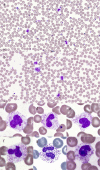Successful treatment of elephant endotheliotropic herpesvirus infection in an Asian elephant (Elephas maximus) calf by oral acyclovir medication: Case report
- PMID: 33239478
- PMCID: PMC7870404
- DOI: 10.1292/jvms.20-0375
Successful treatment of elephant endotheliotropic herpesvirus infection in an Asian elephant (Elephas maximus) calf by oral acyclovir medication: Case report
Abstract
Elephant endotheliotropic herpesvirus (EEHV) is a major cause of death in Asian elephant (Elephas maximus) calves. A 2-year, 11-month-old female, captive Asian elephant presented with facial edema and a mild fever. Blood samples were collected and showed EEHV1A positivity with a high viral load by real time PCR. Heterophil toxicity also was reported for the first time in this case. The calf was treated orally with acyclovir, 45 mg/kg tid for 28 days, which reduced the EEHV1A viral load to undetectable levels within 9 days and the calf survived. A successful outcome with oral acyclovir administration provides another and affordable option to treat EEHV hemorrhagic disease in Asian elephants, and one that is easier to administer in untrained calves.
Keywords: Asian elephant; acyclovir; elephant endotheliotropic herpesvirus (EEHV); heterophil toxicity; oral medication.
Conflict of interest statement
We confirm there are no conflicts of interest.
Figures


Similar articles
-
SUCCESSFUL TREATMENT OF A CLINICAL ELEPHANT ENDOTHELIOTROPIC HERPESVIRUS INFECTION: THE DYNAMICS OF VIRAL LOAD, GENOTYPE ANALYSIS, AND TREATMENT WITH ACYCLOVIR.J Zoo Wildl Med. 2017 Dec;48(4):1254-1259. doi: 10.1638/2016-0141R1.1. J Zoo Wildl Med. 2017. PMID: 29297830
-
ELEPHANT ENDOTHELIOTROPIC HERPESVIRUS ASSOCIATED WITH CLOSTRIDIUM PERFRINGENS INFECTION IN TWO ASIAN ELEPHANT ( ELEPHAS MAXIMUS) CALVES.J Zoo Wildl Med. 2018 Mar;49(1):178-182. doi: 10.1638/2017-0001R1.1. J Zoo Wildl Med. 2018. PMID: 29517457
-
IDENTIFICATION OF TWO LETHAL CASES OF ELEPHANT ENDOTHELIOTROPIC HERPESVIRUS HEMORRHAGIC DISEASE IN SUMATRAN ELEPHANT CALVES IN INDONESIA.J Zoo Wildl Med. 2021 Jan;51(4):985-993. doi: 10.1638/2020-0003. J Zoo Wildl Med. 2021. PMID: 33480579
-
NOVEL DIAGNOSTIC AND THERAPEUTIC APPROACHES TO ELEPHANT ENDOTHELIOTROPIC HERPESVIRUS 1A HEMORRHAGIC DISEASE IN A CAPTIVE JUVENILE ASIAN ELEPHANT (ELEPHAS MAXIMUS).J Zoo Wildl Med. 2022 Mar;53(1):232-240. doi: 10.1638/2021-0096. J Zoo Wildl Med. 2022. PMID: 35339171
-
Review of Elephant Endotheliotropic Herpesviruses and Acute Hemorrhagic Disease.ILAR J. 2016;56(3):283-96. doi: 10.1093/ilar/ilv041. ILAR J. 2016. PMID: 26912715 Free PMC article. Review.
Cited by
-
Multi-Antigen Elephant Endotheliotropic Herpesvirus (EEHV) mRNA Vaccine Induces Humoral and Cell-Mediated Responses in Mice.Vaccines (Basel). 2024 Dec 18;12(12):1429. doi: 10.3390/vaccines12121429. Vaccines (Basel). 2024. PMID: 39772089 Free PMC article.
-
The first reported cases of elephant endotheliotropic herpesvirus infectious haemorrhagic disease in Malaysia: case report.Virol J. 2021 Nov 24;18(1):231. doi: 10.1186/s12985-021-01694-x. Virol J. 2021. PMID: 34819101 Free PMC article.
-
Pharmacokinetics and analytical determination of acyclovir in Asian elephant calves (Elephas maximus).Vet Anim Sci. 2021 Dec 24;15:100227. doi: 10.1016/j.vas.2021.100227. eCollection 2022 Mar. Vet Anim Sci. 2021. PMID: 35024493 Free PMC article.
-
Characterizations of Elephant Endotheliotropic Herpesvirus Type 1A and 4 Co-Infections in Asian Elephant (Elephas maximus) Calves.Vet Sci. 2024 Mar 25;11(4):147. doi: 10.3390/vetsci11040147. Vet Sci. 2024. PMID: 38668415 Free PMC article.
-
Clinical characteristics of elephant endotheliotropic herpesvirus (EEHV) cases in Asian elephants (Elephas maximus) in Thailand during 2006-2019.Vet Q. 2021 Dec;41(1):268-279. doi: 10.1080/01652176.2021.1980633. Vet Q. 2021. PMID: 34511026 Free PMC article.
References
-
- Boonprasert K., Mahasawangku S., Angkawanish T., Jansittiwej S., Langkaphin W., Sombutputorn P., Bampenpol P., Mahanil W.2015. Endotheliotropic herpesvirus treatments in a wild orphan baby Asian elephant (Elephas maximus). In: 10th International Elephant Endotheliotropic Herpesvirus (EEHV) Workshop, Crowne Plaza River Oaks, Houston.
-
- Boonprasert K., Punyapornwithaya V., Tankaew P., Angkawanish T., Sriphiboon S., Titharam C., Brown J. L., Somgird C.2019. Survival analysis of confirmed elephant endotheliotropic herpes virus cases in Thailand from 2006 - 2018. PLoS One 14: e0219288. doi: 10.1371/journal.pone.0219288 - DOI - PMC - PubMed
-
- Brock A. P., Isaza R., Hunter R. P., Richman L. K., Montali R. J., Schmitt D. L., Koch D. E., Lindsay W. A.2012. Estimates of the pharmacokinetics of famciclovir and its active metabolite penciclovir in young Asian elephants (Elephas maximus). Am. J. Vet. Res. 73: 1996–2000. doi: 10.2460/ajvr.73.12.1996 - DOI - PMC - PubMed
Publication types
MeSH terms
Substances
LinkOut - more resources
Full Text Sources
Other Literature Sources

